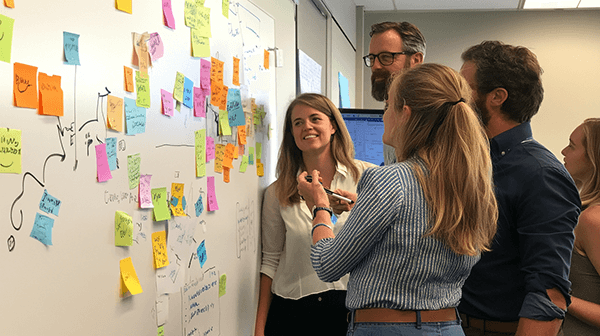Test your Product Concept with the Blueprinting Sprint
You’re closer to a successful new product than you think.
Your team is working on a product concept. Or perhaps it’s just an idea. Meanwhile, company leadership wants you to launch it next year.
And yet… there are questions:
- Does our target customer have a problem this concept solves?
- What is the unique value proposition for this concept?
- How well does this concept address market needs?
The only proven path is through Voice of Customer research, but you don’t have time for extensive studies. Not enough time, anyway.

You’re competing against the clock. But there is a solution.
Leaders are waiting… and impatient. You’ll need to start building new concepts soon to hit your goals for the next year or so.
We have an answer: The Blueprinting Sprint
With the Blueprinting Sprint, our research blitzes are both FAST and ACCURATE. Armed with our jobs-to-be-done methods and empowered by AI technologies, we can deliver results quickly enough to give your engineers the insights they need to get started, often in just four weeks.

Four weeks? How is this possible?
Consider this: An amateur woodworker can build a beautiful table in 100 hours. A professional woodworker can build the same table in ten hours. A manufacturer can build it in less than one. With expertise, experience and process execution, not only was the table built faster, but it was also built better and with fewer defects.
Similarly, The Blueprinting Sprint leverages applied TOC (Theory of Constraints) and jobs-to-be-done methods to expedite discovering and prioritizing customer needs.
How does this work in practice?
We go faster by eliminating constraints.
In Week 1, we address the biggest constraint first: lack of stakeholder alignment. Over two days, we conduct a series of workshops in which we create an innovation strategy. Nothing will slow an initiative down more than misunderstandings and bad communication. These are certain to create rework later. We also begin the customer recruiting process (more on that later).

In Week 2, we will conduct a series of workshops, using jobs-to-be-done methods to produce customer need statements representing the totality of competitive and internal insights. Further, we’ll use JTBD prompts with AI tools, arriving at 95% confidence.
In Weeks 3 and 4, we’ll meet with actual customers to validate and update the list of customer needs. Finally, we launch a survey and analyze the data.
By the following week, four weeks after the initial strategy session, we will discuss the results in a final workshop.

Will The Blueprinting Sprint work in our industry?
Yes!
Over the past two decades, we have executed jobs-to-be-done projects across various industries and coached thousands of teams. Will it work for you? Highly likely, but let’s begin by considering a couple of caveats.
First, AIM has traditionally focused on B2B businesses; therefore, it’s fair to acknowledge that our deepest expertise lies within these markets. If your business is B2C, we must add a few steps to ensure that the survey has a high enough sample size. But will this still work? Yes. We may just need a bit more time.
Second, some customer audiences are harder to reach than others. That’s just a fact of marketing research. Finding welders working on nuclear submarines is harder than finding insurance agents.
With either of these caveats, if your business is more B2C or it’s hard to find customers in your industry, the bad news is that this could extend the project length beyond four weeks. But the good news is that we still can dramatically crunch the schedule much tighter than is possible with conventional methods. And for most projects, an extra week or two is not a major issue.

What does a Blueprinting Sprint cost?
A Blueprinting Sprint costs $45k plus expenses per project. This covers at least five workshops, customer interviews, survey creation, fielding and analysis. Expenses can be kept at a minimum by conducting all workshops virtually. Without travel to be concerned about, typically, the only other expenses that might occur would be when using a third-party service for customer recruitment or industry experts.

Let’s discuss your business and how The Blueprinting Sprint can help you this year.
Select this link to set up a quick 30-minute chat. We can get started as soon as you can.

Imagine You are presenting your new product’s great sales numbers.
You’re on stage, and your smiling colleagues are in the crowd. Your company’s CEO, seated in the front row, is thumbing through a report as he prepares for your presentation. You tell the story about how you CRUSHED conventions for how long this project should have taken. And, of course, you show the results. The numbers go up and to the right.
As you wrap up the presentation and thank the audience, you notice that several C-level folks have been taking notes and are at attention. The CEO gives a final, “Great work. Just great work. Please pass this along to your team.”
